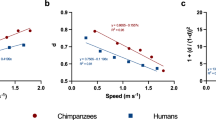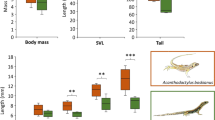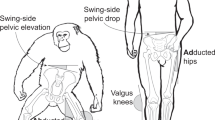Abstract
Recent studies of locomotion in red kangaroos (Megaleia rufa, 18–28 kg)1 and Australian hopping mice (Notomys cervinus, 36.6 g)2 have indicated that over a certain range of speeds the energetic cost of bipedal hopping locomotion may become independent of speed. As much as 70% of the decrement in kinetic energy which takes place when the kangaroo lands may be stored in elastic elements and used to propel the kangaroo upwards and forwards as it takes off (leaving only 30% to be added by the muscles)3,4. Presumably, this same phenomenon could be exploited by all bipedal hopping mammals and it seems possible that at high speeds this specialized mode of locomotion could result in large energetic savings when compared with the costs incurred by a similarly sized quadruped running at the same speed. This hypothetical lower cost of locomotion has been invoked as an explanation for the rather common occurrence of bipedal hoppers among desert and plains dwelling mammals, as it might substantially reduce the energetic cost of foraging, or travelling, for animals utilizing widely dispersed resources5–7. The purpose of the present study was to extend the assessment of the metabolic expense of bipedal hopping to a broader range of body sizes and mammalian taxa. Using indirect calorimetry we measured the cost of locomotion for three bipedal hopping eutherians (0.03–3.0 kg) and one bipedal hopping marsupial (1.1 kg). When properly trained for sustained running, none of the three species deviated from the expected quadrupedal pattern relating cost of locomotion to running speed, even while running fully bipedally. Bipedality must therefore be associated with benefits other than those related to the energetic costs of locomotion.
This is a preview of subscription content, access via your institution
Access options
Subscribe to this journal
Receive 51 print issues and online access
$199.00 per year
only $3.90 per issue
Buy this article
- Purchase on Springer Link
- Instant access to full article PDF
Prices may be subject to local taxes which are calculated during checkout
Similar content being viewed by others
References
Dawson, T. J. & Taylor, C. R. Nature 246, 313 (1973).
Dawson, T. J. Nature 259, 305 (1976).
Cavagna, G. A., Heglund, N. C. & Taylor, C. R. Am. J. Physiol. 233, R243–R261 (1977).
Alexander, R. McN. & Vernon, A. J. zool. Res. 177, 265 (1975).
Reichman, O. J. & Oberstein, D. Ecology 58, 636–643 (1977).
Reichman, O. J. in Mechanisms of Optimal Foraging (Garland, New York, 1979).
Price, M. V. J. Mammal. 59, 624 (1978).
Tucker, V. A. J. exp. Biol. 48, 55 (1968).
Thompson, S. D. thesis, Univ. Calif., Irvine (1980).
Baudinette, R. V., Nagle, K. A. & Scott, R. A. D. Experientia 32, 583 (1976).
Eisenberg, J. F. Univ. Calif. Publs Zool. 63, 1 (1960).
Bartholomew, G. A. Jr & Caswell, H. H. Jr J. Mammal. 32, 155 (1951).
Webster, D. B. Physiol. Zool. 35, 248 (1962).
Eisenberg, J. F. in Rodents in Desert Environments, 189–224 (Junk, The Hague, 1975).
Taylor, C. R., Schmidt-Nielsen, K. & Raab, J. L. Am. J. Physiol. 219, 1104–1107 (1970).
Author information
Authors and Affiliations
Rights and permissions
About this article
Cite this article
Thompson, S., MacMillen, R., Burke, E. et al. The energetic cost of bipedal hopping in small mammals. Nature 287, 223–224 (1980). https://doi.org/10.1038/287223a0
Received:
Accepted:
Issue Date:
DOI: https://doi.org/10.1038/287223a0
This article is cited by
-
Proportional variation and scaling in the hindlimbs of hopping mammals, including convergent evolution in argyrolagids and jerboas
Journal of Mammalian Evolution (2024)
-
The energy allocation trade-offs underlying life history traits in hypometabolic strepsirhines and other primates
Scientific Reports (2021)
-
Paleobiology of Argyrolagus (Marsupialia, Argyrolagidae): an astonishing case of bipedalism among South American mammals
Journal of Mammalian Evolution (2020)
-
Terrestrial locomotion energy costs vary considerably between species: no evidence that this is explained by rate of leg force production or ecology
Scientific Reports (2019)
-
Locomotion energetics and gait characteristics of a rat-kangaroo, Bettongia penicillata, have some kangaroo-like features
Journal of Comparative Physiology B (2003)
Comments
By submitting a comment you agree to abide by our Terms and Community Guidelines. If you find something abusive or that does not comply with our terms or guidelines please flag it as inappropriate.



